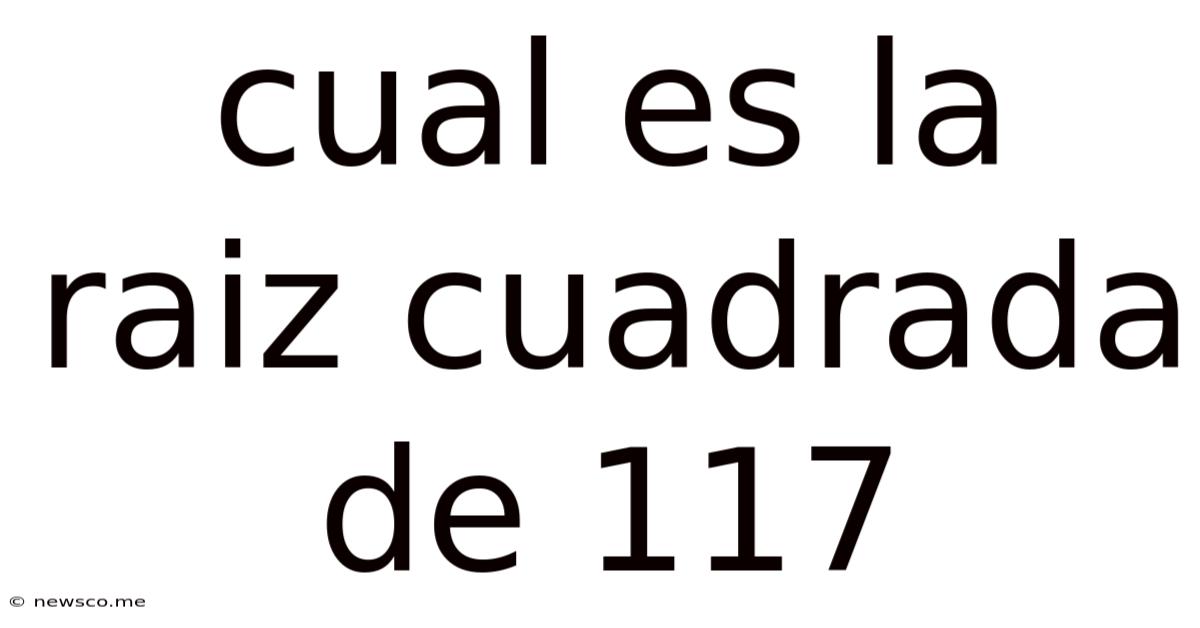Cual Es La Raiz Cuadrada De 117
News Co
May 07, 2025 · 4 min read

Table of Contents
What is the Square Root of 117? A Deep Dive into Square Roots and Approximation Techniques
The question, "What is the square root of 117?" might seem simple at first glance. However, exploring this question opens the door to a fascinating world of mathematical concepts, approximation techniques, and the power of understanding numerical relationships. Let's delve into this seemingly simple question and uncover its deeper meaning.
Understanding Square Roots
Before we tackle the square root of 117 specifically, let's solidify our understanding of square roots in general. The square root of a number is a value that, when multiplied by itself, equals the original number. For example, the square root of 9 is 3, because 3 x 3 = 9. We represent the square root using the radical symbol (√).
This concept extends to all non-negative real numbers. However, finding the exact square root of many numbers, including 117, isn't as straightforward as finding the square root of a perfect square (a number that is the product of an integer multiplied by itself).
Is 117 a Perfect Square?
No, 117 is not a perfect square. Perfect squares have whole number square roots. Let's examine the perfect squares around 117:
- 10² = 100
- 11² = 121
Since 117 falls between 100 and 121, its square root will be between 10 and 11. This gives us a good starting point for our exploration.
Methods for Approximating √117
Because 117 is not a perfect square, we need to employ approximation methods to find its square root. Here are a few common techniques:
1. Babylonian Method (or Heron's Method)
This iterative method refines an initial guess to progressively closer approximations of the square root. The formula is:
xₙ₊₁ = ½ (xₙ + N/xₙ)
where:
- xₙ is the current approximation
- N is the number whose square root we're seeking (117 in our case)
- xₙ₊₁ is the next, improved approximation
Let's use this method, starting with an initial guess of 10.5 (the midpoint between 10 and 11):
- Iteration 1: x₁ = ½ (10.5 + 117/10.5) ≈ 10.82
- Iteration 2: x₂ = ½ (10.82 + 117/10.82) ≈ 10.8167
- Iteration 3: x₃ = ½ (10.8167 + 117/10.8167) ≈ 10.81665
As you can see, the approximation converges quickly. After just a few iterations, we have a highly accurate approximation of √117 ≈ 10.81665.
2. Linear Interpolation
A simpler, though less precise, method is linear interpolation. We use the known square roots of the nearest perfect squares:
- √100 = 10
- √121 = 11
Since 117 is 17 more than 100 (and 4 less than 121), we can estimate:
√117 ≈ 10 + (17/21) * (11 - 10) ≈ 10 + 0.81 ≈ 10.81
This method offers a quick, rough estimate.
3. Using a Calculator
The easiest way to find an approximation is to use a calculator or a computer program with a square root function. Most calculators will provide a result similar to 10.8166538264.
Understanding the Decimal Representation
The decimal representation of √117 (approximately 10.81665) is non-terminating and non-repeating. This means it continues infinitely without a repeating pattern. This is characteristic of the square roots of most non-perfect squares. The approximation we obtain depends on the precision of our method and the number of decimal places we choose to use.
Practical Applications
Understanding square roots has numerous applications in various fields, including:
- Geometry: Calculating the length of the diagonal of a square or rectangle.
- Physics: Solving problems related to velocity, acceleration, and energy.
- Engineering: Designing structures and systems.
- Finance: Calculating compound interest and investment returns.
Further Exploration: Prime Factorization and Square Roots
The prime factorization of 117 is 3² x 13. Notice that because 13 is a prime number and not a perfect square, we cannot simplify √117 further. This highlights the connection between prime factorization and the ability to simplify square roots.
Conclusion: The Square Root of 117
The square root of 117 is not a whole number; it's an irrational number. However, we can approximate its value using various methods, ranging from the iterative Babylonian method to simpler linear interpolation or using a calculator. Understanding these approximation techniques and the underlying mathematical principles provides a deeper appreciation for the nature of square roots and their significance in mathematics and its applications. The value of √117, to several decimal places, is approximately 10.81665. Remember that this is an approximation; the actual value extends infinitely. The exploration of this seemingly simple question has led us on a journey of mathematical discovery, highlighting the power and elegance of mathematical reasoning.
Latest Posts
Latest Posts
-
How Many Cm2 In A M2
May 08, 2025
-
How Long Is 69 Weeks In Months
May 08, 2025
-
10 Ml Is The Same As
May 08, 2025
-
Adding Fractions With A Number Line
May 08, 2025
-
Find The Prime Factorization Of 24
May 08, 2025
Related Post
Thank you for visiting our website which covers about Cual Es La Raiz Cuadrada De 117 . We hope the information provided has been useful to you. Feel free to contact us if you have any questions or need further assistance. See you next time and don't miss to bookmark.